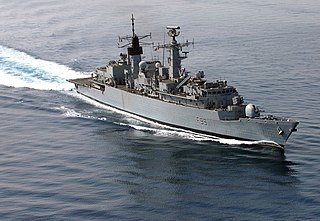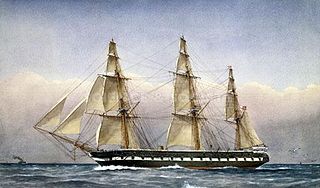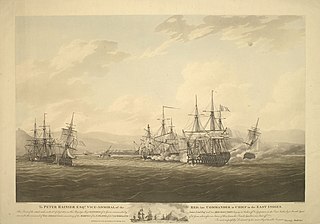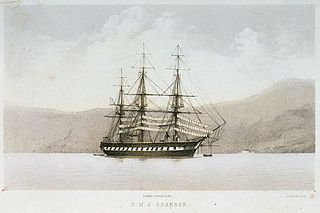
HMS Cornwall was a Batch 3 Type 22 frigate of the Royal Navy. She was the first Batch 3 to be built, and the last to decommissioned. Cornwall was based at HMNB Devonport in Devon, England, part of the Devonport Flotilla.

The first HMS Shah was a 19th-century unarmoured iron hulled, wooden sheathed frigate of Britain's Royal Navy designed by Sir Edward Reed. She was originally to be named HMS Blonde but was renamed following the visit of the Shah of Persia in 1873.

HMS Leander was a 50-gun spar-decked frigate of the Royal Navy which saw service in the Napoleonic Wars, the War of 1812, and the Second Barbary War.

The British Royal Navy's ironclad Admiral-class battleships of the 1880s followed the pattern of the Devastation class in having the main armament on centreline mounts fore and aft of the superstructure. This pattern was followed by most following British designs until HMS Dreadnought in 1906. They were known as the Admiral class because they were all named after British admirals, such as Admiral George Anson.

HMS Britannia was a 120-gun first-rate ship-of-the-line of the Royal Navy, laid down in 1813 and launched on 20 October 1820.

HMS Hercules was a central-battery ironclad of the Royal Navy in the Victorian era, and was the first warship to mount a main armament of 10-inch (250 mm) calibre guns.

HMS Hannibal was a 74-gun third-rate ship of the line of the Royal Navy, launched on 15 April 1786, named after the Carthaginian general Hannibal. She is best known for having taken part in the Algeciras Campaign, and for having run aground during the First Battle of Algeciras on 5 July 1801, which resulted in her capture. She then served in the French Navy until she was broken up in 1824.

HMS Chesapeake was a Royal Navy screw-propelled 51-gun frigate launched in 1855, with a crew of 510 men. She saw action during the Second Opium War and there is a memorial to her losses at Southsea, near Portsmouth. She was the flagship of the British China Squadron in 1861.

HMS Furious was a 16 gun steam powered paddle wheel frigate of the Royal Navy built at Portsmouth Dockyard and launched on 26 August 1850. She was the lead ship of the two ship class of Furious-class frigate. She was built at a cost of £64,794, of which her machinery cost £24,577.

The Foudroyant was an 80-gun ship of the line of the French Navy. She was later captured and served in the Royal Navy as the Third Rate HMS Foudroyant.

HMS President was a large frigate in the British Royal Navy (RN). She was built to replace the previous HMS President, redesignated from the heavy frigate USS President built in 1800 as the last of the original six frigates of the United States Navy under the Naval Act of 1794. The first President had been the active flagship of the U.S. Navy until captured while trying to escape the Royal Navy blockade around New York in 1815 at the end of the War of 1812, and then served in the RN until broken up in 1818. The new British President was built using her American predecessor's exact lines for reference, as a reminder to the United States of the capture of their flagship – a fact driven home by President being assigned as the flagship of the North America and West Indies Station in the western Atlantic Ocean under the command of Admiral Sir George Cockburn (1772–1853), who had directed raids throughout the Chesapeake Bay in 1813–1814 that culminated in the 1814 burning of official buildings in the American capital, Washington, D.C.

HMS Marlborough was a first-rate three-decker 131-gun screw ship built for the Royal Navy in 1855. She was begun as a sailing ship of the line, but was completed to a modified design and converted to steam on the stocks, and launched as a wooden steam battleship.
Kingfisher was a sloop engaged in merchant trading out of Victoria, British Columbia, Canada to First Nations peoples around Vancouver Island and adjoining waters. During trading with the Ahousaht Nation, a part of the Nuu-chah-nulth in Clayoquot Sound late in 1864 the vessel was attacked and its captain, a Captain Stephenson, and three crew members were massacred. HMS Devastation, a small gunboat, was dispatched to the scene but due to overwhelming superiority of Ahousaht forces waited for reinforcements, which came in the form of the screw frigate HMS Sutlej and its fifty guns. Holding offshore from Marktosis, one of the main Ahousaht communities, Admiral Denman, commander of the vessel, demanded the surrender of Chapchah, who had masterminded the killings. When the residents refused, Denman opened fire on the village, destroying it. Subsequently, the village of Moyat and others were destroyed by shellfire and incendiary rockets from Sutlej.

HMS Inconstant was a 36-gun Perseverance-class fifth-rate frigate of the Royal Navy. She had a successful career serving in the French Revolutionary and Napoleonic Wars, capturing three French warships during the French Revolutionary naval campaigns, Curieux, Unité, and the former British ship HMS Speedy.

HMS Glasgow was a wooden screw frigate, the fifth ship of the name to serve in the Royal Navy.

HMS Centurion was a 50-gun Salisbury-class fourth rate of the Royal Navy. She served during the American War of Independence, and during the French Revolutionary and Napoleonic Wars.

HMS Malta was an 80-gun third rate ship of the line of the Royal Navy. She had previously served with the French Navy as the Tonnant-classGuillaume Tell, but was captured in the Mediterranean in 1800 by a British squadron enforcing the blockade of French-occupied Malta. Having served the French for less than four years from her completion in July 1796 to her capture in March 1800, she would eventually serve the British for forty years.

HMS Shannon was a Liffey-class steam frigate of the Royal Navy.

Terrible was originally a 74-gun ship of the line of the French Navy launched in 1739. Captured on 14 October 1747, she was taken into Royal Navy service as the third rate HMS Terrible.

HMS Leander was a 50-gun frigate of the Royal Navy which saw service in the Crimean War.




















